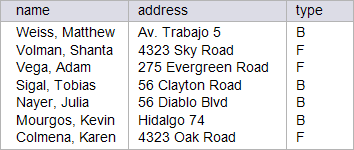SELECT |
| A SELECT command takes a set of tables (tables and/or views) and a set of filters to return a given set of rows. SELECT can be thought of as a command that builds a table from the tables or views that exists in a database. The SELECT command is the most used in SQL. Un comando SELECT toma un juego de tablas (o vistas) con un conjunto de restricciones para consultar un grupo dados de renglones. El comando SELECT puede pensarse como un comando que construye tablas de las tablas y vistas que existen en la base de datos. El comando SELECT es el más usando en el lenguaje SQL. |
| Problem 1 |
| city_bank > Write an SQL command to list all the data in the client table. From Microsoft Visual Studio menu New > SQL file. If you cannot select the database, you need to run the script once so that the databases appear in the dropdown list. Escriba un comando SQL para listar todos los datos de la tabla client. Desde el menú de Microsoft Visual Studio Nuevo > Archivo de SQL. Si no puede seleccionar la base de datos, usted necesita ejecutar el script una vez para que las bases de datos se muestren en la lista desplegable. |
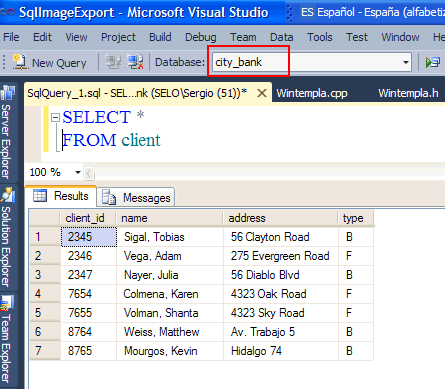
An Asterisk |
| * denotes the SELECT command must display all the columns of the table. This comes handy when you are working with a new database and want to get a sense of what the table data is like. Never use the asterisk when creating applications with SQL. For instance, if the number of columns in the table increases or decreases the application may crash. * se usa para solicitar todas las columnas de las tablas. Usualmente este se usa cuando no se conoce la tabla y se desea tener una idea de la estructura de la tabla. Nunca utilice el asterisco para solicitar todas las columnas cuando cree una aplicación con SQL ya que esto podría causar problemas. Por ejemplo, si el número de columnas en la tabla aumenta o disminuye, el programa buscará el mismo número de columnas que cuando el programa fue escrito y con toda seguridad fallará. |
WHERE |
| The command WHERE limits the returned or affected rows during an SQL operation. WHERE is a searching or filtering condition to return (or affect) only those rows that meet the condition. La palabra clave WHERE permite incluir solamente ciertos renglones de datos en una operación de SQL. WHERE es una condición de búsqueda o filtrado para retraer (u operar) sólo en los renglones que cumplan con la condición. |
| Tip |
When a WHERE is used in an SQL command, it may happen:
Cuando se usa un WHERE en un comando SQL puede ocurrir que:
|
| Problem 2 |
| city_bank > Test the following SELECT command. Pruebe el siguiente comando SELECT. |

| Problem 3 |
| city_bank > Test the following SELECT command. Pruebe el siguiente comando SELECT. |

| Problem 4 |
| city_bank > Test the following SELECT command. Pruebe el siguiente comando SELECT. |
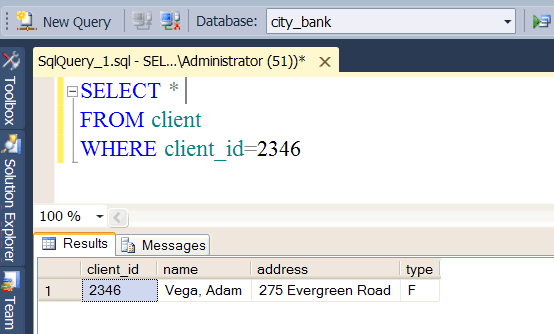
| Problem 5 |
| city_bank > Test the following SELECT command. Pruebe el siguiente comando SELECT. |
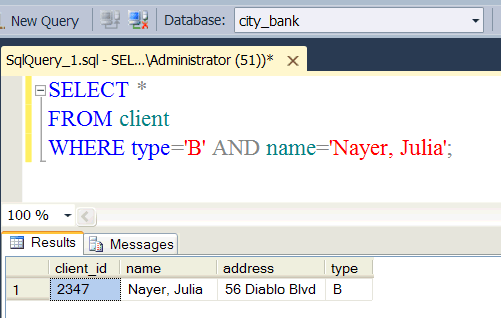
| Problem 6 |
| city_bank > Test the following SELECT command. Pruebe el siguiente comando SELECT. |
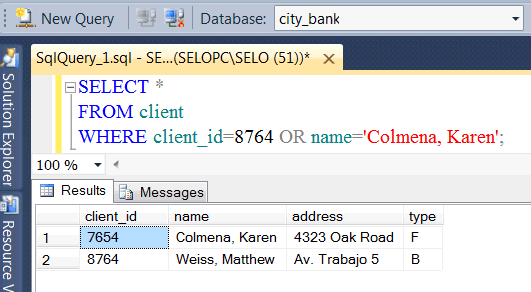
| Problem 7 |
| city_bank > Write an SQL command to display the clients with an client_id greater than 7000. The command must also show 'Vega, Adam'. Escriba un comando SQL para mostrar los clientes con client_id mayor a 7000. El comando debe también mostrar a 'Vega, Adam'. |

| Problem 8 |
| city_bank > Test the following SELECT command. Pruebe el siguiente comando SELECT. |
| SQL |
| SELECT name FROM client |

| Problem 9 |
| city_bank > Write an SQL command to display the name of the branches and their addresses. Escriba un comando SQL para mostrar los nombres de las sucursales con sus direcciones. |

| SQL |
| SELECT name, address FROM branch |
| Problem 10 |
| city_bank > Test the following SELECT command. Pruebe el siguiente comando SELECT. |
| SQL |
| SELECT friend_id, name, birth_date FROM friend WHERE birthdate IS NULL; |

| Problem 11 |
| city_bank > Test the following SELECT command. Pruebe el siguiente comando SELECT. |
| SQL |
| SELECT friend_id, name, birth_date FROM friend WHERE birth_date IS NOT NULL; |

| Tip |
| NULL values provide a three-valued logic in SQL. i.e., Fax information; you can store the fax number, use NULL to specify that you don't have that information or leave it blank when someone does not have a fax. Avoid using NULL value as much as possible. Los valores NULL proporcionan una lógica de tres valores, por ejemplo el número de fax, el cual se deja en blanco cuando alguien no tiene fax, se llena con NULL para especificar que la persona no se sabe si tiene fax, o se coloca el número de fax. Evite usar valores NULL tanto como pueda. |
| Problem 12 |
| city_bank > Test the following SELECT command. Pruebe el siguiente comando SELECT. |
| SQL |
| SELECT client_id FROM client_account; |
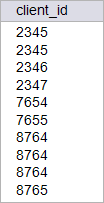
| Tip |
| Duplicate rows occur when the primary key of a table is left out of the SELECT command. Cuando la llave primaria no se incluye en un comando SELECT, los renglones de una tabla pueden aparecer más de una vez al realizar una consulta. |
DISTINCT |
| You prevent duplicate rows when you use DISTINCT, that is, all rows will be different. Avoid the use of DISTINCT as it will make difficult to find errors in your statements. Este comando SQL evita que los renglones en una consulta aparezcan más de una vez, esto es, los renglones serán únicos. Evite el uso de DISTINCT ya que este puede dificultar encontrar errores en sus comandos. |
| Problem 13 |
| city_bank > Test the following SELECT command. Pruebe el siguiente comando SELECT. |
| SQL |
| SELECT DISTINCT client_id FROM client_account; |
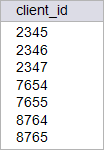
| Problem 14 |
| city_bank > Write an SQL command to display the account_id of those accounts with a balance greater than 100 dollars. Escriba un comando SQL para mostrar las account_id de aquellas cuentas con un balance mayor a 100 dolares. |
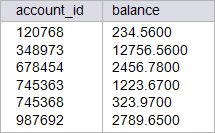
| Problem 15 |
| city_bank > Write an SQL command to display the type of those accounts with a balance greater than 100 dollars. Escriba un comando SQL para mostrar el tipo de aquellas cuentas con un balance mayor a 100 dolares. |
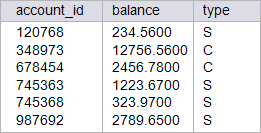
ORDER BY |
| It enables you to sort your data in either ascending or descending order. In most databases, new rows are inserted at the bottom of the tables. Este comando SQL permite ordenar los datos en forma ascendente o descendente. Note que en la mayoría de las bases de datos los nuevos renglones a una tabla estos se insertan en la parte inferior de la tabla. |
| Problem 16 |
| city_bank > Test the following SELECT command. Pruebe el siguiente comando SELECT. |
| SQL |
| SELECT name, address, type FROM client ORDER BY name ASC |
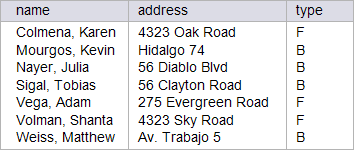
| Problem 17 |
| city_bank > Test the following SELECT command. Pruebe el siguiente comando SELECT. |
| SQL |
| SELECT name, address, type FROM client ORDER BY name DESC |
